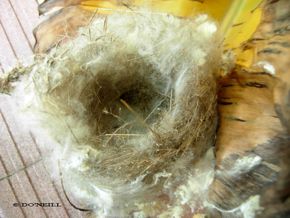“While chirpy calls of Common Tailorbirds (Orthotomus sutorius) can be heard frequently in correct habitats such as homes and public gardens, open cultivated areas and woodlands; to go looking for active nesting sites is something else. Unless the specific assignment is of utmost scientific value and of importance, it is a detrimental and invasive hobby, I have no wish to neither pursue nor indulge in.
“As fate would have its way to dictate its choice of such a reluctant observer, my first sighting of a newly fledged nest came and landed right in side front of my door step a year ago!
“A pair of Common Tailorbirds had stealthily constructed their nest on a distal end of a banana leaf of a dwarf banana species called Banana boat aka. ‘Pisang Kapal’ (Musa acuminata AAA Group). The sapling was a gift from a dear old friend – Inche Wahab Ghani who once lived in my neighborhood.
“Due to space constraint, I could only grow the non-commercial sucker sapling as an ornamental plant in a large flowering pot and content to sparingly harvest its foliage usefully during laundry days. (A hot iron run over a cut leaf would lift up its wax onto the hot plate iron, hence providing a smooth glide during the ironing process.)
“Several species of birds visit my small front garden regularly to forage for insects and nectar.
“Just over a year ago in April 2011, distressed calls of a breeding pair of Common Tailorbirds were heard. One bird I remembered was seen perched close to a flowerpot next to the banana plant. As I was about to take leave on a birding trip, I paid no attention to investigate further.
“My presence over the steps could have disturbed their chick feeding routine or parents were trying to fledge their chicks on that day. What ever they were doing, or had done earlier, they were cleverly executed without my knowledge. Least to expect was to have them build a nest in my garden-which has never happened before.
“After my returned trip, the hidden nest, less than two feet off ground was accidentally discovered on pruning day when a withered banana leaf branch received Avian Writer’s execution (above left, front view; above right, rear view).
“It showed the artistry skills of the parenting birds – the distal end of the leaf folded into a conch shape, held together and stitched in with silk fibers.
The nest was taken down and placed on the steps for closer examination. If readers can visualise each of the brick coloured tile is 1sq. ft, one could estimate the overall size of the tailorbird’s nest (below left).
“Building materials appear to comprise of silky fibres, dried twigs and grass bits well padded in with kapok and fashioned into a deep, cozy, cupped shape. The leaf had punctured holes spaced out at random intervals where fibres were threaded through, leaving notched ends to secure the parts together (above right).
“This special technique that is unique to nest building of these tailors certainly as earned their names- ‘Tailorbirds’.
“Two discarded empty egg shells were found. One on the floor, the other was collected from a neighboring flower pot of the banana plant. I presume they once came with their chicks in them (above).
“For measurements of Common Tailorbird’s nest, may I conclude and pleasure readers to take on a D.I.Y. assignment to research bird guidebooks for further references…”
Avian Writer Daisy O’Neill
Copyright article and copy images:
Courtesy of Daisy O’Neill Bird Conservation Fund
Penang, Malaysia
8th June 2012
















2 Responses
a good example of probably how it gets it local name “Perenjak Pisang” or in older literature “Kelicap Pucat Pisang”. Nice find…..
Yes Daisy, well done. Have had Common Tailorbirds nesting in our garden before and one active nest right now. So share your excitement. Watching from afar to limit disturbance.